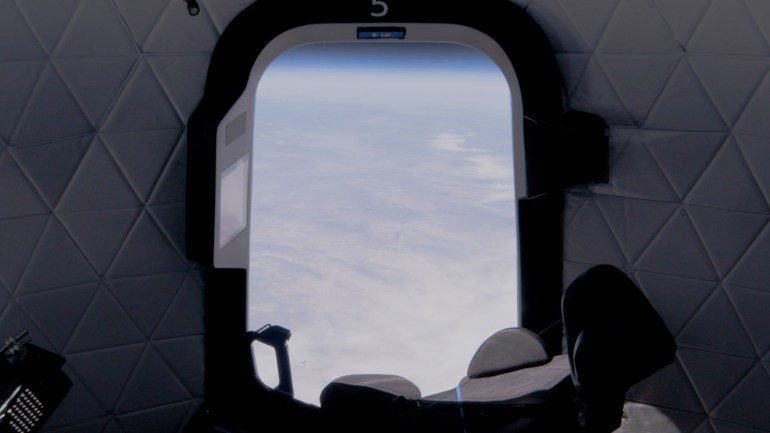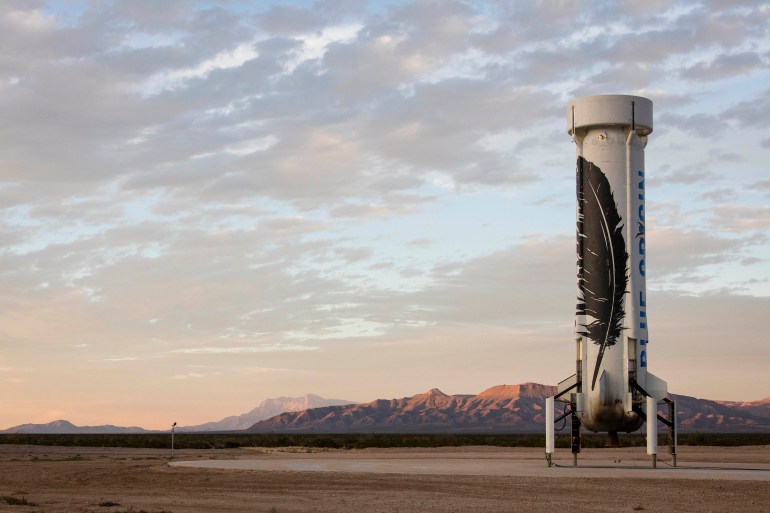Space tourism: Bezos’s Blue Origin sets first flight for July | Space News
Jeff Bezos’s Blue Origin is set to begin ferrying paying passengers into suborbital space on its New Shepard rocket this summer and is auctioning off the last remaining seat on its inaugural flight.
“We’re ready, it’s game time,” Ariane Cornell, Blue Origin’s director of astronaut sales, told Al Jazeera.
On May 5, 1961, Alan Shepard became the first American in space. Sixty years later, Blue Origin announced the rocket that bears his name is ready to make its first crewed flight.
So far, specific details on pricing and future flights have not yet been disclosed, but the company did open up a public auction for the final seat on its first flight, with proceeds benefitting the company’s Club for the Future, a non-profit organisation promoting science, maths, engineering, and technology careers.
Sealed online bidding will run for two weeks from Wednesday, with aspiring space tourists allowed to bid any amount. Those bids will become public on May 19, with the contest will conclude with a live auction on June 12.
The winner will have just more than a month to prepare for their first trip into suborbital space.
Exploring suborbital space
Blue Origin’s New Shepard rocket and crew capsule are designed to carry six people and scientific equipment just beyond an invisible line, known as the Karman line, which separates Earth from space.
Both the rocket and the crew capsule are fully reusable and have completed 15 test flights over the past few years to prepare for the ultimate goal of transporting people. Capsules on previous flights have reached altitudes of 100km (about 62 miles).
Large windows on the capsule treat passengers to stunning views as they spend roughly 10 minutes in zero gravity, where they can float within the cabin before returning to Earth.
 Large windows on the capsule treat passengers to stunning views as they spend roughly 10 minutes in zero gravity, where they can float within the cabin before returning to Earth [Courtesy: Blue Origin]
Large windows on the capsule treat passengers to stunning views as they spend roughly 10 minutes in zero gravity, where they can float within the cabin before returning to Earth [Courtesy: Blue Origin]To get past the Karman line, the crew capsule with passengers inside is launched atop the rocket. The rocket then detaches and lands itself. After reaching its goal, the capsule then descends by parachute before touching down in the Texas desert.
During the company’s latest test flight in April, company executives dressed as astronauts ran through preflight tests and procedures to prepare for launching people. They then disembarked the vehicle before launch.
Blue Origin told Al Jazeera that the exercise was “a verification step for the vehicle and operations before flying astronauts”. Now that the company has run through its astronaut checkouts, it says it is ready to begin flying people in July.
First in flight
So who will actually fly on Blue Origin’s rocket? Five of the six seats on the first flight will be filled by astronauts Blue Origin plans to name at a later time. The sixth seat will go to the winner of the auction — if they meet the requirements, that is.
According to the fine print, the winning astronaut must weigh between 49kg (110 pounds) and 101kg (223 pounds) and should be between 5 feet (1.5 metres) and 6 feet 4 inches (2 metres) in height.
Passengers should also be able to withstand forces of up to 3gs for a couple of minutes during ascent (or up to three times their weight), and five-and-a-half times their weight (or 5.5gs) for a few seconds during the descent into the atmosphere, the company said.
Cornell said specific details on the other passengers will come at a later date and that the company has a few more crewed flights planned before the end of the year.
Once it begins carrying people, Blue Origin will be competing for space tourism dollars with Richard Branson’s Virgin Galactic.
 Blue Origin’s New Shepard booster is shown following a successful test flight [Credit: Blue Origin]
Blue Origin’s New Shepard booster is shown following a successful test flight [Credit: Blue Origin]The British company has already started selling seats on its vehicle, called SpaceShipTwo. Those seats are going for $250,000 for people who signed up early. More recently, the company announced that it would charge more than that for subsequent sign-ups, but has not disclosed its new price yet.
Veteran NASA astronaut Thomas Jones said these flights will be like reliving Alan Shepard’s first flight.
“On this trajectory, passengers will get about five to 10 minutes of weightlessness,” Jones told Al Jazeera, “and the entire ride from motor ignition to landing will be roughly 30 minutes.”
Blue Origin is not the only space company to auction a seat on its crew capsule.
Billionaire Jared Issacman booked four seats on a SpaceX Dragon crew capsule as part of a mission called Inspiration4.
To raise money for St Jude Children’s Research Hospital, an organisation devoted to treating children with cancer, Issacman auctioned off one seat and chose the winner of a second seat via a fundraising campaign run through his company.
The final seat on Isaacman’s flight went to Hayley Arceneaux, a cancer survivor and current physician’s assistant working at St Jude.
That flight, launching this fall, will be the first all-private citizen mission to space.
